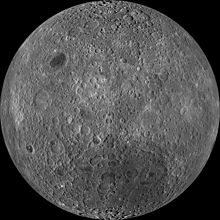Solar System/Moon
Appearance

Size
[edit | edit source]The Moon's diameter is 3476 kilometers, or 0.2764 times that of Earth. This makes the Moon far larger relative to its planet than any other planetary moon in the solar system. In absolute terms it is the fifth largest planetary satellite in the solar system.
Physical characteristics
[edit | edit source]The surface
[edit | edit source]
The maria and terrae
[edit | edit source]The enigma of the craters
[edit | edit source]Water in the craters
[edit | edit source]Seismology
[edit | edit source]
Moonquakes
[edit | edit source]Internal structure
[edit | edit source]Magnetism
[edit | edit source]Atmosphere
[edit | edit source]Origin and evolution
[edit | edit source]Large impact hypothesis
[edit | edit source]The large impact hypothesis is a theory that states that the Moon was formed when a Mars sized protoplanet collided with the Earth during the Hadean eon of the Earth, with the debris from the impact accreting into the moon. The named of the mars sized protoplanet is usually given as Theia. It is the most widely accepted hypothesis for the formation of the moon.
Age of the Moon
[edit | edit source]The Conquest Of The Moon
[edit | edit source]
